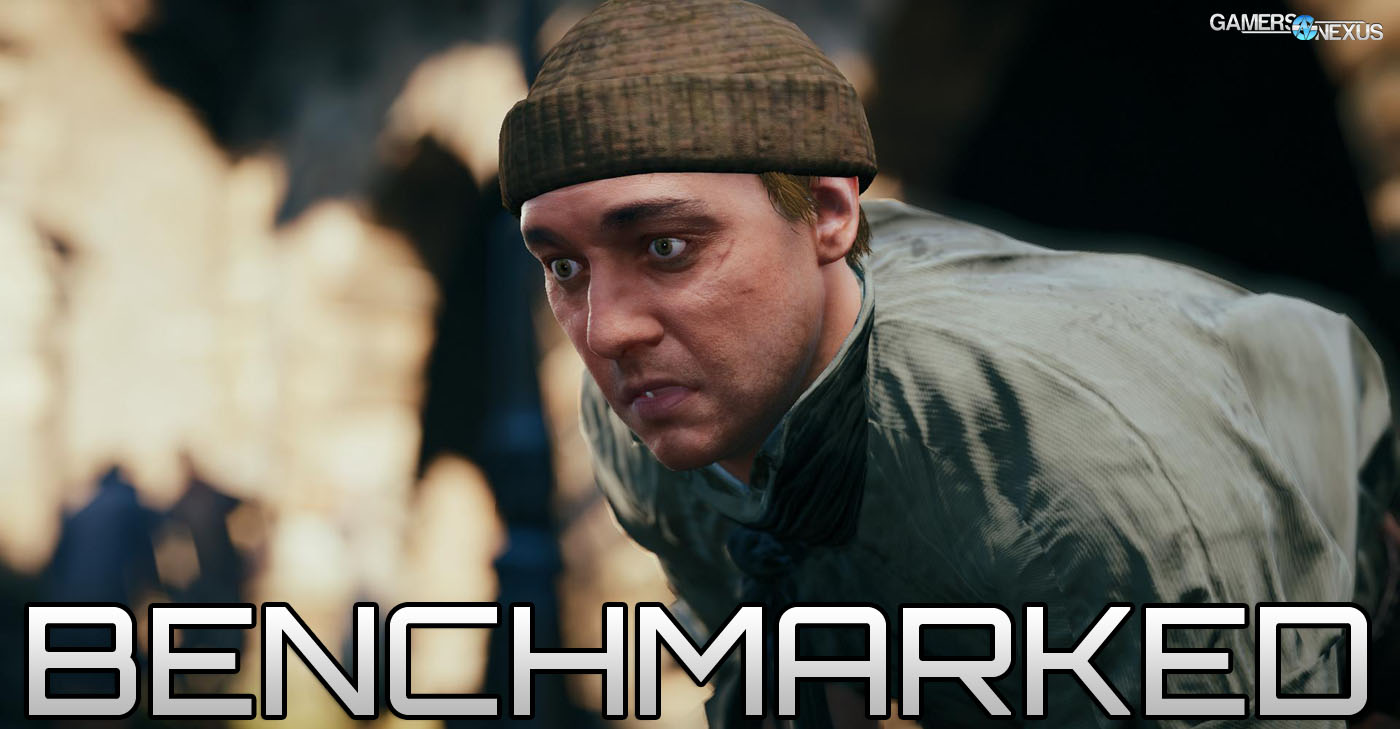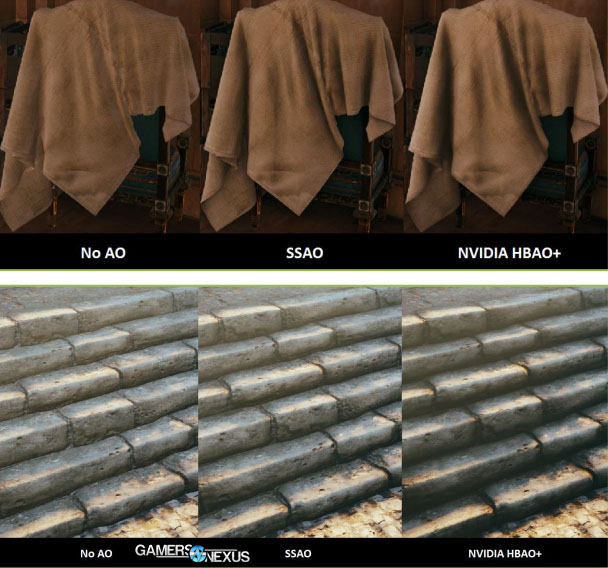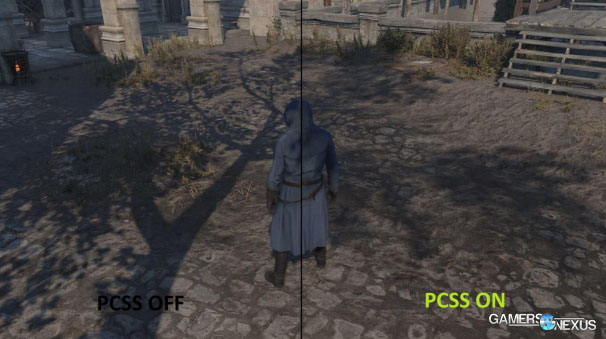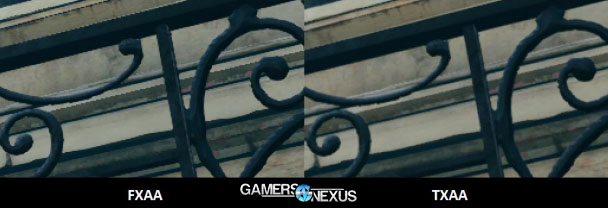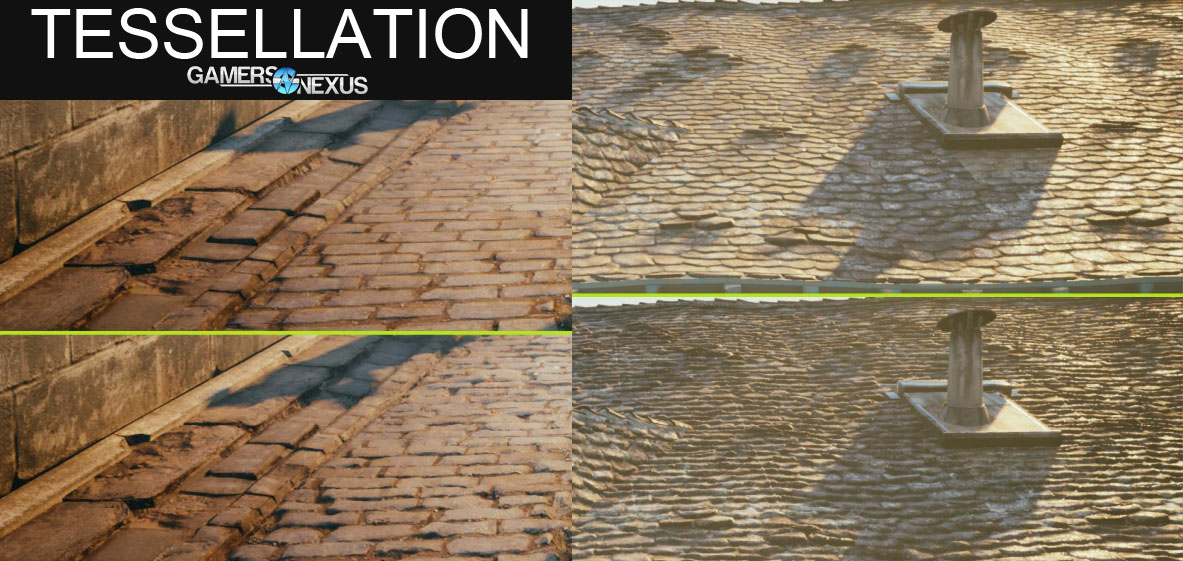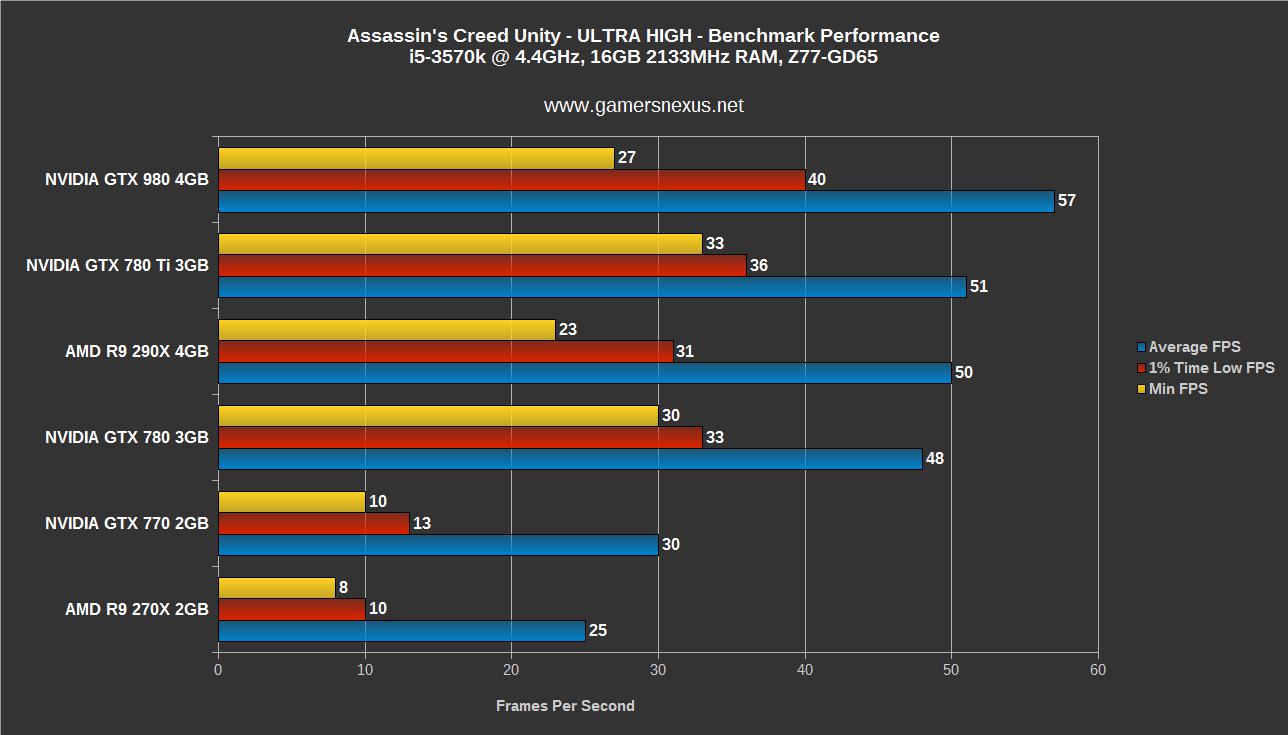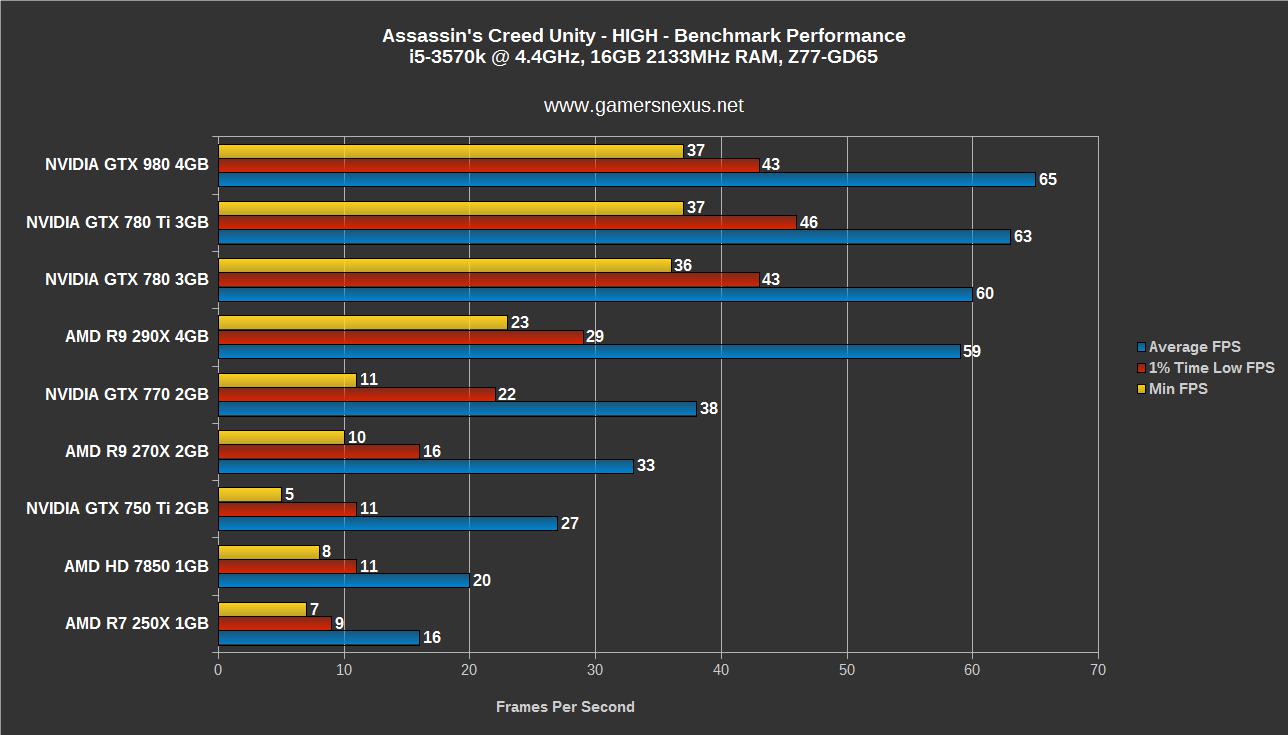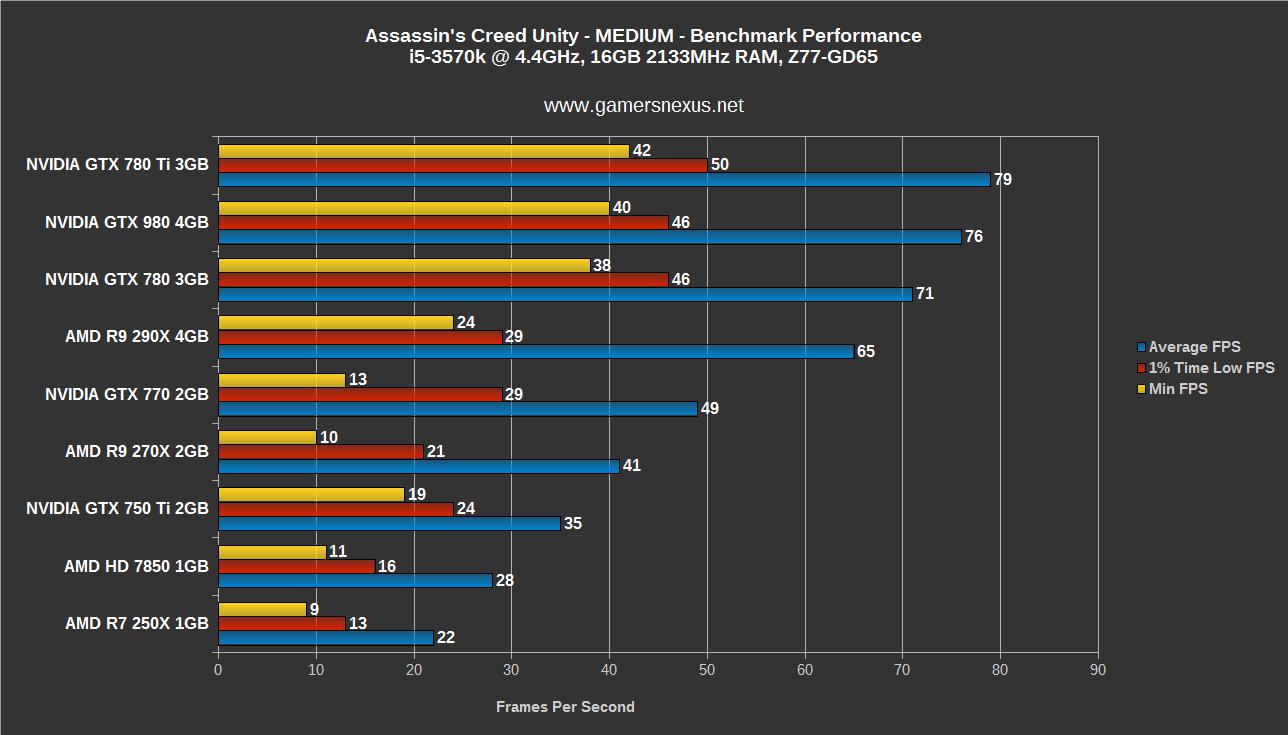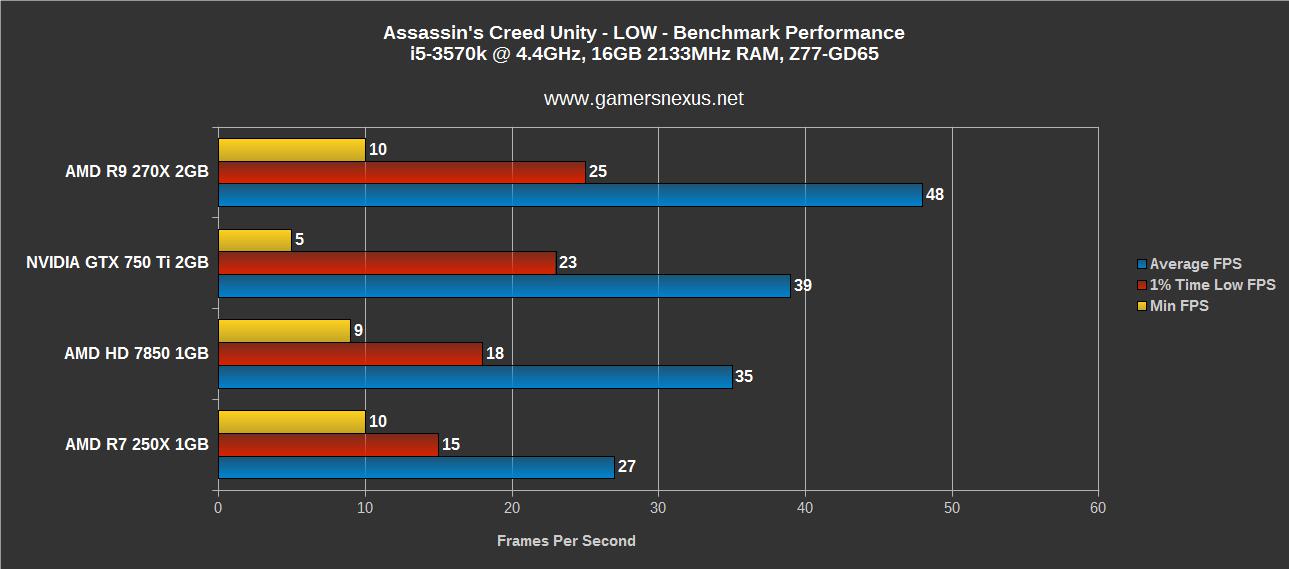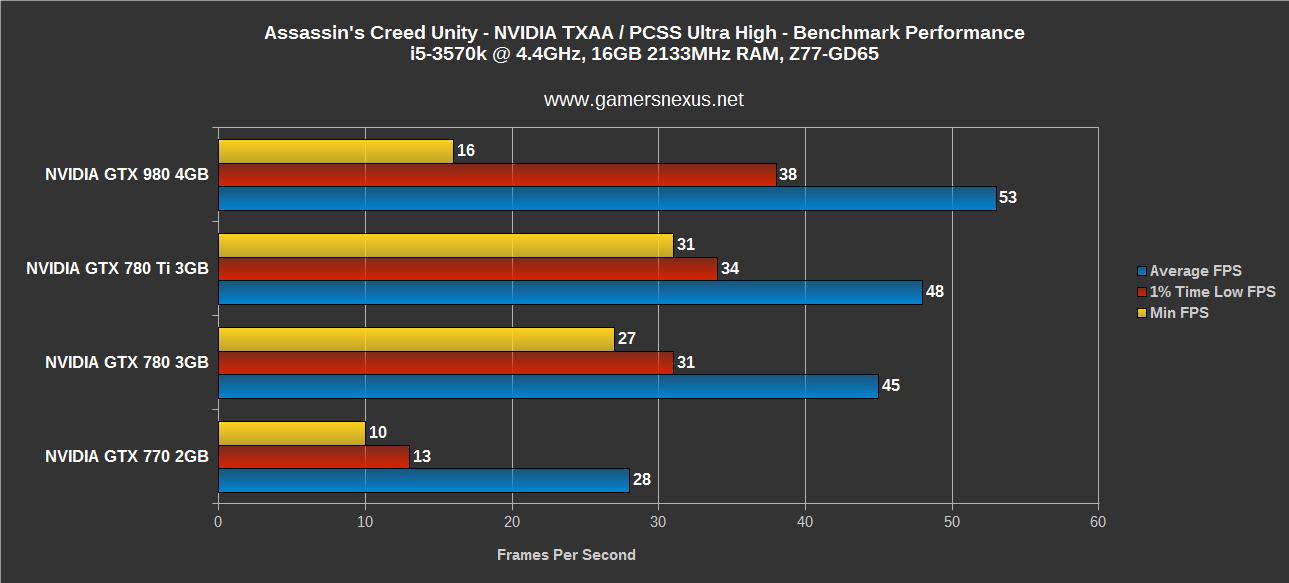Assassin's Creed Unity GPU Benchmark – 4GB VRAM Use, GTX 980 vs. Others
Posted on November 12, 2014
In a somewhat promising turn for the industry, Assassin's Creed Unity ($60) uses almost all of the VRAM we were able to throw at it. We'll get into that shortly. Regardless of the game's mechanics and value (reviewed here), there's no arguing that Assassin's Creed Unity has some of the most graphically-impressive visuals ever produced for a PC game. In coordination with nVidia and its GameWorks suite (detailed), Ubisoft implemented new Percentage Closer Soft Shadows, TXAA, and ShadowWorks technology to soften and blur lines between cast shadows. Not all graphics technologies require nVidia video cards.
In this GPU benchmark, we look at the best video cards for Assassin's Creed Unity for max (Ultra High) settings and other settings; our test pits the GTX 980 vs. GTX 780 Ti, 770, R9 290X, 270X, and more. Low settings tests are also included. Further, we checked RAM and VRAM consumption while playing ACU, hoping to further determine the game's most demanded resource.
Assassin's Creed Unity Max Settings (Ultra High) Gameplay Video
(Note: We just published an Assassin's Creed crash fix article, for those struggling with CTDs and other black screen / stutter issues).
Our Other Assassin's Creed Content
Before getting started, here are our most relevant ACU articles:
- Gaming PC Build for Assassin's Creed Unity on Max Settings.
- Assassin's Creed Critical Review - A Slowing in Pace.
- Assassin's Creed Crash Fixes.
Assassin's Creed Unity Graphics Technology
ACU introduces some of the game industry's most complex NPC crowd programming, loading system resources heavily with demanding draw calls and CPU-intensive AI / pathing. Assassin's Creed often features several dozen NPCs rendered simultaneously, each with full collision detection and responses to player movement.
Soft bodies – cloth in flags and clothing, for instance – are physically interactive and respond to character movement and wind, further increasing demand on system resources. Particle effects aren't quite as impressive as what we've seen in Lords of the Fallen's movement-responsive fog, but are still present and demanding. Smoke plumes billow from the occasional rooftop, fog hangs where appropriate, and mist can be seen low to the ground in some environments.
The usual bombardment of lighting technologies makes a presence, too; light is traced through numerous bounces, decaying in luminosity as the source grows increasingly distant. HBAO+ and SSAO (both ambient occlusion technologies) create a deeper appearance to objects by following contours with shadows that change in intensity. HBAO+ saw improvements in its ACU implementation, especially centered around grass and leaf coverage and the interaction between foliage and light. It is predicted by nVidia that HBAO+ renders approximately 30% faster than HBAO.
Related to the world of lighting is the inclusion of PCSS, or Percentage Closer Soft Shadows. PCSS smooths shadows so that they're less perfect, similar in high-level concept to reducing the sharp, jagged edges of objects with anti-aliasing. PCSS sharpens shadows as they approach the casting source, but then blurs the lines as shadows gain distance from the source (like a tree's leaf shadows vs. the trunk's base shadow). PCSS also makes for smoother shadow casting upon dynamic objects, like characters passing through shaded sectors of the map. To quote our review guide, because it states the functionality most concisely:
“PCSS builds upon regular shadow mapping. It does this by shading each pixel in camera space, and then computing the penumbra size by analyzing the average distance to occluded objects.”
On the front of nVidia-centric technologies, ACU hosts TXAA among the usual MSAA anti-aliasing options.
MSAA, or multisample anti-aliasing (explained in depth here), takes a certain count of color samples per pixel, then blends the colors together to smooth out object edges. With MSAA 4X, the GPU will sample each pixel four times, combine those data points, and determine the correct pixel color. Increasing MSAA sample rate is exponentially more expensive for the GPU, since we're increasing the per-pixel sample rate. MSAA 8X at 1920x1080 resolution would be sampling billions of times per second, a task that becomes intensely GPU-bound.
TXAA is nVidia's approach to anti-aliasing with an emphasis on higher quality filtering. The resource cost can be thought of as slightly more expensive than MSAA 4X, but the output is similar (slightly better) in appearance. TXAA reduces “temporal aliasing,” which is the appearance of crawling or flickering edges when the screen is in motion. Nvidia's anti-aliasing technology samples the inside and outside of the pixels based upon samples from previous frames, providing an additional layer of filtering and eliminating some of the movement-based flickering. The difference can be seen most immediately with foliage (tall grass) or fences (skinny bars) that would traditionally flicker as the player moved the camera.
Finally, Assassin's Creed Unity looks to implement tessellation in the near future. Tessellation was not present at the time of our benchmarking (11/11/14), but should see introduction in the next major graphics patch. Tessellation will add depth to surfaces that historically only see texturing. In a practical implementation, an example would be cobblestone walls or streets (textured) that are tessellated, resulting in realistic depth (those textured surfaces now look like individually-modeled stones, not just a flat texture). From our review guide, here's the explanation of this tech:
“Adaptive tessellation factor calculation and frustum culling [intercept] DirectX draw calls, analyze the vertex shader currently being used, and adds its own tessellation shaders. Developers simply feed the displacement map generated by the Displacement Map Tool and set up the tessellation factor and displacement scale.”
The result is something like this:
I'm excited to test the resource draw of tessellation once fully implemented.
Test Methodology
The above is a video overview of our benchmark course. Follow the same path to replicate our tests. The video shows Assassin's Creed Unity at max settings (Ultra High) with PCSS, HBAO+, and TXAA at nearly 60FPS / 1080p. (Note: the video was still uploading at time of publication, but should be online shortly).
We ran an identical 120-second circuit in the heart of Paris for each test.
For analysis of VRAM consumption, we logged GPU metrics using GPU-Z and analyzed them after the benchmarks. RAM consumption was analyzed with the native system resource monitor.
We tested Assassin's Creed Unity on several video card configurations with a constant host platform. The ACU FPS benchmark was conducted using several different settings within the game: a custom "NVIDIA-only" setting (everything ultra high, PCSS, TXAA), a preset "Ultra High" setting with high shadows and MSAA 4X, the and "high," "medium," and "low" presets.
All tests were conducted three times for parity, each using a custom ACU graphics benchmark course. We used FRAPS' benchmark utility for real-time measurement of the framerate, then used FRAFS to analyze the 1% high, 1% low, min, max, and average FPS.
NVidia 344.65 stable drivers were used for all tests conducted on nVidia's GPUs. AMD 14.11.1 beta drivers were used for the AMD cards.
| GN Test Bench 2013 | Name | Courtesy Of | Cost |
| Video Card | (This is what we're testing). XFX Ghost 7850 | GamersNexus, AMD, NVIDIA, CyberPower, ZOTAC. | Ranges |
| CPU | Intel i5-3570k CPU Intel i7-4770K CPU (alternative bench). | GamersNexus CyberPower | ~$220 |
| Memory | 16GB Kingston HyperX Genesis 10th Anniv. @ 2400MHz | Kingston Tech. | ~$117 |
| Motherboard | MSI Z77A-GD65 OC Board | GamersNexus | ~$160 |
| Power Supply | NZXT HALE90 V2 | NZXT | Pending |
| SSD | Kingston 240GB HyperX 3K SSD | Kingston Tech. | ~$205 |
| Optical Drive | ASUS Optical Drive | GamersNexus | ~$20 |
| Case | Phantom 820 | NZXT | ~$130 |
| CPU Cooler | Thermaltake Frio Advanced | Thermaltake | ~$65 |
The system was kept in a constant thermal environment (21C - 22C at all times) while under test. 4x4GB memory modules were kept overclocked at 2133MHz. All case fans were set to 100% speed and automated fan control settings were disabled for purposes of test consistency and thermal stability.
A 120Hz display was connected for purposes of ensuring frame throttles were a non-issue. The native resolution of the display is 1920x1080. V-Sync was completely disabled for this test.
A few additional tests were performed as one-offs to test various graphics settings for impact.
The video cards tested include:
- AMD Radeon R9 290X 4GB (provided by CyberPower).
- AMD Radeon R9 270X 2GB (we're using reference; provided by AMD).
- AMD Radeon HD 7850 1GB (bought by GamersNexus).
- AMD Radeon R7 250X 1GB (equivalent to HD 7770; provided by AMD).
- NVidia GTX 780 Ti 3GB (provided by nVidia).
- NVidia GTX 770 2GB (we're using reference; provided by nVidia).
- NVidia GTX 750 Ti Superclocked 2GB (provided by nVidia).
- GTX 970 4GB
- GTX 980 4GB
Assassin's Creed Unity VRAM & RAM Consumption
In testing Assassin's Creed Unity, we determined that the game uses substantially more video card memory than we've seen in most other current titles. When equipped with 4GB video cards, ACU demanded an impressive 3221MB (3.2GB) of static video RAM, with dynamic (reserve) usage tacking on an additional ~250MB consumed. Our total max consumption of GDDR5 memory rested at around 3.5GB.
It looks like higher capacity video cards are finally getting saturated. In fact, in the benchmark graphs below, it becomes clear that capacity impacts performance more than we've seen in past titles.
As for system memory, consumption hovers at around 2.1-2.3GB at any given time. We'd like to see games use more if they've got the need for RAM, but it's a start.
Storage consumption, just to make a point, closes in on 50GB of disk space required.
Assassin's Creed Unity Benchmark: GTX 980 vs. GTX 780 Ti, 770, R9 290X, 270X
Below are all of the resulting graphs from our benchmarking endeavors. We tested the game using these settings:- “Ultra High” without PCSS (“High” instead) and with MSAA 4X to ensure a more equal cross-architecture comparison.
- “Ultra High” with PCSS and TXAA (NVIDIA-only benchmark).
- “Medium” preset.
- “Low” preset.
Assassin's Creed Unity has some intense graphics. The requirements appear to match the intensity, pushing the GTX 980 to its limits on “Ultra High” at just 1080p. We found the GTX 980's framerate (roughly 60FPS) to be fully playable in ACU, though the devices that output less than 50FPS would need graphics settings tweaks to ensure smooth playback. Performance drops marginally for NVIDIA devices with PCSS and TXAA enabled, but the smoothness of motion is worth the barely-noticeable FPS drop for GTX users.
Using the “high” preset, everything until the GTX 770 sustains a playable framerate. Some graphics optimization tweaks on the GTX 770 would enable a hybrid high-medium setup with playable framerates.
“Medium” settings yield playable FPS all the way down to the GTX 770, though we'd still make some tweaks. Performance gains for the flagship cards become significantly less noticeable (non-linear gains).
“Low” settings tests were only conducted on low-end GPUs, with only the 270X (technically mid-range) surviving playably. You will not be able to play Assassin's Creed Unity on anything less than a GTX 760 or R9 270X while holding a 1080p resolution. Note that driver or game software optimization patches could change this fact.
Not shown in these charts is the GTX 970, which would perform effectively the same as the GTX 780 (potentially a bit better).
Optimization is Questionable
The game is beautiful. There's absolutely no doubt about that. We'll be using it as a benchmarking utility for all immediate-future video card testing, which speaks to the game's stress-testing nature. Unfortunately, stress-testing doesn't translate well to playability. Unity feels like it's poorly optimized for mid-range hardware – a GTX 770 should be able to play the game with greater efficacy at high settings; there's an issue of scaling down the graphics, I think, especially when it comes to the crowds.
Disabling AA and/or lowering shadows would improve performance to more reasonable levels, though all of the presets use some sort of AA, so this will need to be manually tweaked outside of the preset.
It seems that nVidia's offerings are optimized a bit better at the moment, but driver updates to Catalyst may change that.
What's The Best Video Card for Assassin's Creed Unity?
Based on our tests, assuming you want to run a 1080 display, you're going to need some higher-end hardware to play ACU adequately. If you're content with medium settings, the GTX 970, R9 280X, or above would be ideal. Some manual tweaking of the settings would allow a GTX 760 to play at a modest FPS, though it'd be a medium/low hybrid. Players seeking maximum settings will require a flagship card, like the GTX 980 or R9 290X. It is clear to us that ACU places great emphasis on higher VRAM capacities, so do take that into consideration when shopping. We'd recommend 3GB or more.
My shortlist would be:
- R9 280X ($200 – 3GB VRAM and an affordable solution make medium settings a possibility, especially with MSAA tweaking).
- GTX 970 ($400 – best performance-to-value for Assassin's Creed Unity at medium+ settings).
- GTX 980 4GB ($580 – best performance, but pricey; streamers will almost definitely want something like the 980).
- Steve “Lelldorianx” Burke.
